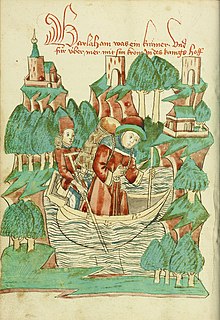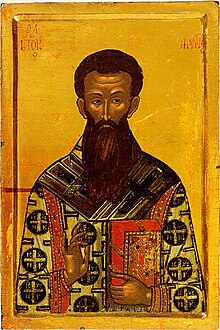Barlaam of Calabria
Barlaam of Calabria ( Middle Greek Βαρλαὰμ Καλαβρός , * around 1290 in Seminara , Calabria ; † 1348 in Avignon ) was a southern Italian cleric and scholar who worked in the 14th century. He briefly played an important role in the church policy of the Byzantine Empire and in Orthodox theology , but fell out of favor with the Byzantine emperor in the dispute over the hesychasts . He later became Bishop of Gerace in southern Italy.
Life
Barlaam was born in Seminara in Calabria, southern Italy, where he grew up in a Greek Orthodox environment. At a young age he became a monk in the Basilian monastery of S. Elia in Galatro , where he acquired an extensive education. He studied the Greek and Latin languages as well as ancient philosophy (especially Plato and Aristotle ) and the currents of scholasticism ( Thomas Aquinas , Johannes Duns Scotus ). He was considered to be an excellent expert on Greek from an early age and taught Dante Alighieri in this field , among others . In order to deepen his knowledge, he moved to Aetolia and Thessaloniki .
Between 1325 and 1330 he went to Constantinople , where he challenged the most important Byzantine scholar Nikephoros Gregoras . Although he succumbed to his opponent in a public discussion of philosophy and astronomy, he gained a reputation as a scholar and the trust of the Byzantine emperor Andronikos III . So he negotiated in 1334/35 on behalf of the emperor with the legates of Pope John XXII . Apparently stimulated by his intercourse with Catholics , he subsequently published a series of theological writings in which he criticized the Western Church for the Filioque and for the primacy of the Pope. In 1339 the emperor sent him to Avignon as an envoy, where he met Pope Benedict XII. negotiated the overcoming of the oriental schism . Barlaam was supposed to promise the papists the unity of the Christian church and in return demand support in the fight against the Turks threatening the Byzantine Empire. However, the negotiations failed.
Barlaam played a very ambiguous role in this dispute, both praising and criticizing the Catholic Church in his writings. The legend of Popess Joan, for example, was spread through the writings of Barlaam. Otherwise he published many theological, philosophical and mathematical works as well as a music theory book in which he refuted the theses of Nikephoros Gregoras on the harmony of Claudius Ptolemy . Since around 1336 Barlaam got into a theological dispute with Gregorios Palamas and the hesychasm led by him , a mystical-spiritual movement that had originated on Mount Athos and was particularly distinguished by special praying and breathing techniques. Palamas had come into Barlaam's field of vision after critically reading Barlaam's writings and publishing his criticism. Barlaam then found out about Palamas and the hesychasts, whose prayer methods and theology he took offense.
Both scholars subsequently published pamphlets against the other and his teachings. However, Barlaam's contributions to this theological dispute have not survived and can only be inferred from the works of the Palamas. Emperor Andronikos III. inclined to the side of the hesychasts, which became clear by 1341 at the latest: On June 10th of that year, Barlaam's complaints about the hesychasts were officially declared null and void at a synod presided over by the emperor. Barlaam was sentenced and repudiated his teaching. He then left Constantinople and returned to the West, where he converted to Roman Catholicism.
With the Pope in Avignon and in Renaissance Italy in general , his nominalistic humanism had better chances. Initially working as a librarian in Naples , he soon went to Avignon, where he was ordained a priest. In 1342 the Pope appointed him Bishop of Gerace in Calabria. There he maintained contacts with Francesco Petrarca , whom he taught, and Paolo da Perugia . 1346/47 he returned on behalf of Pope Clement VI. back to Constantinople one more time to negotiate again about the union of the churches. However, the situation was unfavorable and Barlaam returned to Avignon, where he died in July 1348. In 1351 another prohesychastic synod took place in Byzantium, at which the opponents of the Palamas were finally condemned. The remaining supporters of Barlaam were excommunicated.
literature
- John A. Demetracopoulos: Barlaam of Calabria. In: Laurent Cesalli, Gerald Hartung (ed.): Outline of the history of philosophy . The philosophy of the Middle Ages. Volume 1: Byzantium, Judaism. Schwabe, Basel 2019, ISBN 978-3-7965-2623-7 , pp. 127-133, 271
- Friedrich Wilhelm Bautz : Barlaam of Calabria. In: Biographisch-Bibliographisches Kirchenlexikon (BBKL). Volume 1, Bautz, Hamm 1975. 2nd, unchanged edition Hamm 1990, ISBN 3-88309-013-1 , Sp. 373.
- Antonis Fyrigos: Barlaam v. Calabria . In: Walter Kasper (Ed.): Lexicon for Theology and Church . 3. Edition. tape 2 . Herder, Freiburg im Breisgau 1994, Sp. 6-7 .
- Karl von Jan : Barlaam 2 . In: Paulys Realencyclopadie der classischen Antiquity Science (RE). Volume III, 1, Stuttgart 1897, Col. 23 f.
- Gerhard Podskalsky : Barlaam of Calabria . In: Religion Past and Present (RGG). 4th edition. Volume 1, Mohr-Siebeck, Tübingen 1998, Sp. 1109.
- Dietrich Stein: Barlaam from Calabria . In: Lexicon of the Middle Ages (LexMA). Volume 1, Artemis & Winkler, Munich / Zurich 1980, ISBN 3-7608-8901-8 , Sp. 1469 f.
- Franz Tinnefeld : Barlaam of Calabria . In: Theologische Realenzyklopädie (TRE). Volume 5, de Gruyter, Berlin / New York 1980, ISBN 3-11-007739-6 , pp. 212-215.
Remarks
- ^ So by Jan, in: RE, Vol. III, 1, Col. 24.
- ↑ 1325: Podskalsky, in: RGG, vol. 1, col. 1109 and Fyrigos, in: LThK, vol. 2, col. 6; 1328: Bautz, in: BBKL, vol. 1, column 373 and Tinnefeld, in: TRE, vol. 5, p. 212; around 1330: Stein, in: LexMA, vol. 1, col. 1469.
- ↑ On this by Jan, in: RE, Vol. III, 1, Col. 24.
- ↑ On the Hesychast dispute in detail Tinnefeld, in: TRE, vol. 5, col. 213-214.
| personal data | |
|---|---|
| SURNAME | Barlaam of Calabria |
| ALTERNATIVE NAMES | Barlaam of Seminara, Βαρλαάμ Καλαβρός |
| BRIEF DESCRIPTION | southern Italian cleric and scholar |
| DATE OF BIRTH | around 1290 |
| PLACE OF BIRTH | Seminara , Calabria |
| DATE OF DEATH | 1348 |
| Place of death | Avignon |

